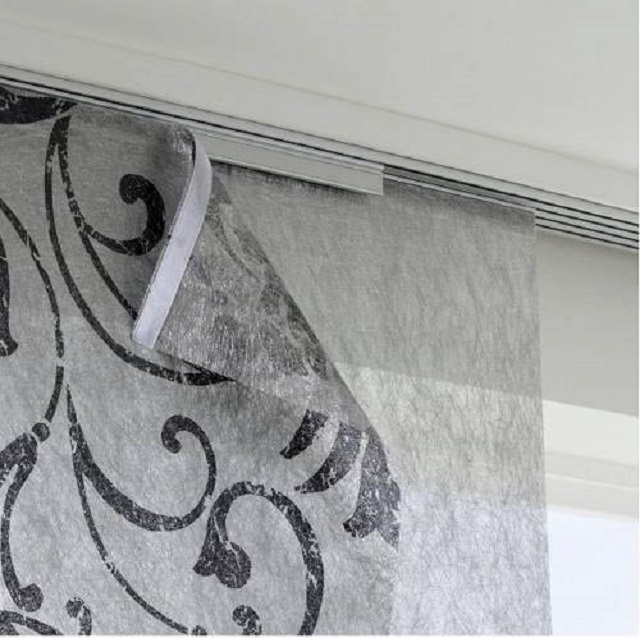Cornices for Japanese curtain panels
Japanese curtains cannot be denied elegance and practicality, but they owe their popularity to a greater extent to the functionality that the cornice provides for them. It is thanks to a special cornice that they can be hung over a window, a door, a wall niche or used as compartment doors and interior partitions, and alternating in different ways, differing in color and texture of the canvas, in a matter of minutes transform the appearance of the room. And if you decide to decorate your home with fabric panels, you will have to take care to choose the right curtain rod for them.
What should be the Japanese cornice
The main design feature of Japanese curtains is that they are not folded, but tightly stretched over special frames or using weighting strips. Thanks to this, they can be lined up, one after another or swapped without removing from the eaves. Therefore, only multi-profile cornices are suitable for them, and the number of tracks on them depends on the number of canvases that make up the curtains.
In order for the canvases to be freely moved and interchanged, each of them will need a separate guide track, but if such free movement is not planned, there may be fewer guides (at least one guide for two canvases). Runners with plates attached to them are inserted into the tracks, on which, in turn, the panels are attached.
 The photo shows an example of an aluminum cornice with 5 guides and manual control
The photo shows an example of an aluminum cornice with 5 guides and manual control  The photo shows an example of attaching curtains to runners using adhesive tape
The photo shows an example of attaching curtains to runners using adhesive tape Control mechanisms for Japanese curtain rods
There are three types of Japanese curtain control on the ledge:
- Independent manual. Fabric panels are moved along the window, holding them with your hands.
- Dependent manual. To set the curtains in motion, you need to pull the cord or chain. In this case, all canvases depend on each other and move either all together or in pairs.
- Automatic. The eaves are equipped with the electric motor working from the panel or the switch.
If the window is of standard size, a double or triple curtain and a manually operated cornice will be enough for it. For wide windows or panoramic glazing, you will need curtains consisting of four or more panels, which are more convenient to control with an electric drive.

 Motorized metal cornice fixed to the ceiling
Motorized metal cornice fixed to the ceiling When choosing between cornices with manual, rope and electric control, keep in mind: on a simple cornice, panels can be placed and swapped in any sequence, and on a cornice with a rope or automatic mechanism, only according to the same pre-set pattern.
Manufacturing materials
Most often, curtain rods for Japanese curtains are made from high-quality plastic or metal (aluminum or steel). They are selected based on the following recommendations:
- Simple plastic curtain rods are the most common and fairly cheap option, but they are only suitable for small windows and light curtains. Curtains with a large weight, he can not withstand.
- For heavy curtains consisting of four or more canvases, an aluminum curtain rod is better suited to withstand their weight and not bend.
- If it is planned to arrange panoramic glazing with Japanese curtains, it is recommended to choose an automatically controlled steel cornice that can withstand heavy loads without loss of operational properties and presentation.
Do-it-yourself cornice installation
To install a curtain rod, it is not necessary to invite professionals. You can also handle this task on your own. Since most cornices can be attached to both the wall and the ceiling at will, it is necessary to determine the place of attachment before installing them.
For work you will need:
- electric drill with a puncher;
- screwdriver or screwdriver;
- fasteners (comes with a cornice);
- pencil and ruler.
Operating procedure:
- Inspect the attachment point, step back from heating pipes, radiators or other heating elements. Please note that the curtains should fall freely, without touching the window sill and the battery. Make sure there are no electrical wires running through the drill holes.
- To set the cornice perfectly even, use a pencil and a ruler to make markings. Pay attention to which direction the window sashes open, and when marking, take into account the distance for their opening.
- The distance between the fasteners should be 0.3 - 0.7 m. If the window or future partition is large, the load on the cornice increases. Therefore, the step between the fasteners must be at least half a meter. On a small window, it is enough to fix the cornice in 3 places (at the edges and in the middle).
- Drill holes for fasteners according to the markup. Install the cornice.
- Tighten fasteners. Press lightly on the bracket to see if it can withstand the load.
- Install the curtains and thread the lower weights into them. Check out the whole structure in action. Make sure all panels move smoothly and freely.
 To fully use all the possibilities of Japanese curtains, you need to choose the “right” cornice
To fully use all the possibilities of Japanese curtains, you need to choose the “right” cornice The basic principle of the formation of the Japanese interior: only the necessary and nothing more, applies to curtain rods. They should be reliable, have a simple shape and not stand out against walls or ceilings. Such a cornice will be a worthy addition to the screen panels and will make your life more comfortable.
